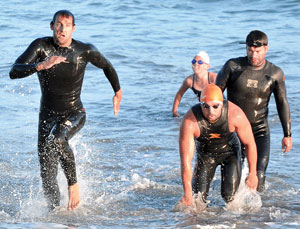What is the speed advantage of a wetsuit?
Everyone knows wetsuits help keep you warm in cold water. Lesser known among the general public (but well-known among triathletes) is that wetsuits also make you swim faster! The buoyant neoprene in a wetsuit floats a swimmer higher in the water, decreasing drag and thus increasing swim speed.
But how much faster is a wetsuit? I’ve heard various rules of thumb: 10% speed increase; 4-6 seconds per 100m; 1 minute per kilometer. I’ve also heard various caveats: it depends on the swimmer’s skill (better swimmers benefit less); it depends on the swimmer’s body-type (naturally floaty people benefit less); it depends on the quality of the wetsuit (you get what you pay for); it depends on the fit of the wetsuit; and so forth.
So the answer is: It depends. Because I’m usually disinclined to let things go at “it depends,” I decided to conduct a field experiment. Reef & Run, which I’ve written about previously, provided the perfect laboratory. Almost every Thursday evening between June 21 and yesterday, August 23, I swam one mile in the ocean at East Beach in Santa Barbara. Two weeks were canceled because of shark sightings, and one week I was sick – leaving a sample of 7 swims.
The swim took place at the same time each Thursday: 6:30pm. The conditions were generally similar: low-mid 60s water temp; winds out of the W or SW, producing moderate surface chop and a W-to-E current (i.e., head current going out, tail current coming back). I would characterize them as “rough water conditions” - the view in the above photo is typical. The course was identical each week - a full mile (1609 meters) measured with GPS, and marked by permanently installed buoys.
Generally, I had done a full workout earlier in the day, plus one lap of the course as warm-up. So, for each of these races I was warmed-up but perhaps a touch fatigued. In any case - pretty close to an ideal setup for my field experiment.
My wetsuit is a cheap-o XTERRA Vortex sleeveless, which frankly doesn’t fit me very well. So - a conservative test of the wetsuit effect. Presumably, I would be even faster in a high-end, well-fitting, full-body wetsuit.

Me in the orange cap. Three-time Olympic water polo player Wolf Wigo at left. The two others in the photo were doing a different race. Photo by Mike Eliason, Santa Barbara News-Press
Of the seven races, I wore a wetsuit for four of them and went “naked” for three of them.
My wetsuit-assisted times were: 19:52*, 20:02, 20:14, and 20:14.
My “naked” times were: 21:36, 21:37, and 21:41.
For the purpose of this analysis, I’m throwing out the 19:52 wetsuit-assisted time. That was the season opener, and it was different in several respects: gorgeous, flat conditions; bigger, more competitive field (thus more drafting opportunities). I’m not surprised I was substantially faster that week.
That leaves a sample of six times - three wetsuit-assisted and three “naked.” My average wetsuit time was 20:10, with a range of 12 seconds. My average “naked” time was 21:38, with a range of 5 seconds.
So, according to my field experiment, my personal “wetsuit effect” - even with an ill-fitting cheap-o sleeveless - was 1 minute, 28 seconds in an open-water mile. That converts to 5.5 seconds per 100m, or a speed effect of 7.3%.
Any other self-experimenters out there? Please leave your data in the comments!
